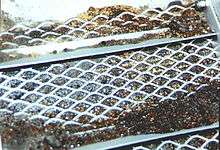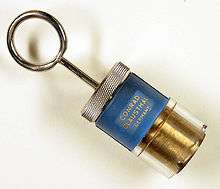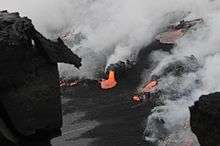Black sand

Black sand is sand that is black in color. One type of black sand is a heavy, glossy, partly magnetic mixture of usually fine sands, found as part of a placer deposit. Another type of black sand, found on beaches near a volcano, consists of tiny fragments of basalt.
While some beaches are predominantly made of black sand, even other colour beaches (e.g. gold and white) can often have deposits of black sand, particularly after storms. Larger waves can sort out sand grains leaving deposits of heavy minerals visible on the surface of erosion scarps.
Placer deposits


Black sands are used by miners and prospectors to indicate the presence of a placer formation. Placer mining activities produce a concentrate that is composed mostly of black sand. Black sand concentrates often contain additional valuables, other than precious metals: rare earth elements, thorium, titanium, tungsten, zirconium and others are often fractionated during igneous processes into a common mineral-suite that becomes black sands after weathering and erosion.
Several gemstones, such as garnet, topaz, ruby, sapphire, and diamond are found in placers and in the course of placer mining, and sands of these gems are found in black sands and concentrates. Purple or ruby-colored garnet sand often forms a showy surface dressing on ocean beach placers.
Basalt fragments
When lava contacts water, it cools rapidly and shatters into sand and fragmented debris of various size. Much of the debris is small enough to be considered sand. A large lava flow entering an ocean may produce enough basalt fragments to build a new black sand beach almost overnight. The famous "black sand" beaches of Hawaii, such as Punalu'u Beach and Kehena Beach, were created virtually instantaneously by the violent interaction between hot lava and sea water.[1] Since a black sand beach is made by a lava flow in a one time event, they tend to be rather short lived since sands do not get replenished if currents or storms wash sand into deeper water. For this reason, the state of Hawaii has made it illegal to remove black sand from its beaches. Further, a black sand beach is vulnerable to being inundated by future lava flows, as was the case for Hawai'i's Kaimū, usually known simply as Black Sand Beach, and Kalapana beaches.[2] An even shorter-lived black sand beach was Kamoamoa.[3]Unlike with white and green sand beaches, walking barefoot on black sand can result in burns, as the black sand absorbs a greater fraction of the solar radiation falling upon it.[4][5]
Black sand beaches
Black sand has formed beaches in various places, including the below.[6][7][8]
Europe
- Italy
- Georgia
- Greece
- Iceland
- Portugal
- Spain
United States
- Black Sand Beach, Prince William Sound, Alaska, United States
- Black Sand Beach, Lost Coast, California
- Hawaii
- Big Island
- Punalu'u Beach
- Kehena Beach
- Kaimū, Hawaii (destroyed by lava flow in 1990)
- Richardson Beach, Hilo
- Maui
- Honokalani Black Sand Beach and Waiʻanapanapa Black Sand Beach in Waiʻanapanapa State Park
- Oneʻuli Beach[9] also known as Naupaka Beach[10]
- Big Island
Mexico
- Playa Patzcuarito (Nayarit)
- Playa La Ventanilla (Oaxaca)
Central America
- Costa Rica
- Guatemala
- Monterrico, Champerico, Puerto Quetzal
- Panama
- Las Lajas, Chiriquí Province[11]
- El Salvador
- Playa El Tunco
Caribbean
- Saint Vincent and the Grenadines
- Montserrat (most beaches except Rendezvous Beach)
- St. Eustatius
- St. Kitts
- Nevis
- Jamaica
- Dominica (most beaches)
- St. Lucia
- Grenada
- Venezuela
- Puerto Rico (Barceloneta, Machuca's Garden)
Puerto Rico, Vieques Playa Prieta
Asia
North Atlantic
- Vík í Mýrdal, Iceland
North Pacific
South Pacific
- New Zealand
- Tahiti
Indian Ocean
See also
References
| Wikimedia Commons has media related to Black sand. |
- ↑ "Magma, Lava, Lava Flows, etc.". USGS.
- ↑ http://www.hawaiicon.com/blog/big-island-kalapana-and-kaimu-beaches
- ↑ http://www.deseretnews.com/article/80684/HAWAIIS-NEWEST-BLACK-SAND-BEACH.html?pg=all
- ↑ "Absorbed Solar Radiation". The Engineering Toolbox.
- ↑ "Black sand and burnt feet: be careful on Auckland's West Coast". 100% Pure New Zealand.
- ↑ http://www.toptenz.net/top-10-black-sand-beaches.php
- ↑ http://experience.usatoday.com/beach/story/best-beaches/2015/02/05/colorful-sands/22946971/
- ↑ http://traveltips.usatoday.com/islands-black-sand-beaches-105856.html
- ↑ http://www.hawaii-guide.com/maui/beaches/oneuli_beach_black_sand_beach
- ↑ http://mauiguidebook.com/beaches/oneuli-black-sand-beach-naupaka/
- ↑ http://www.frommers.com/destinations/panama/763776
